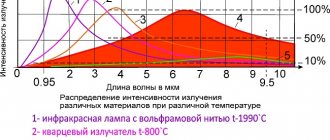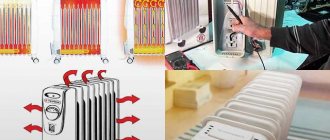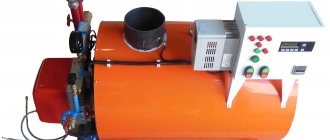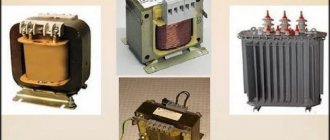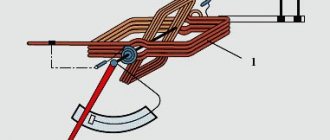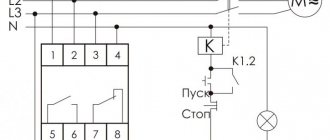Gas infrared heater: design and principle of operation
Infrared heaters differ from all others in that they heat not the air, but objects that are in their area of action.
Heated objects are already heating the air. Moreover, all this is much faster and more efficient than with air heating. But we must remember that very quickly they create a comfortable temperature in a certain zone - where the radiation is directed. In a few hours the whole room will become comfortable. The specific time depends on the type of walls, the ratio of the volume of the room and the power of the unit. Compared with gas guns, the effect of gas infrared convectors lasts longer: they heat the walls, floor and ceiling, objects, and they, in turn, heat the air in the room. Gas infrared heaters come in different shapes and types, but the principle of operation is the same for all. The main element is a ceramic plate with many small holes. Ceramics are special, which when heated to a certain temperature emits heat in the infrared range.
Infrared gas heater: operating principle
Gas is supplied to the device inlet, where it is mixed with atmospheric air. At the outlet of the mixer, a flammable gas-air mixture is obtained, which is supplied through a diffuser to the ceramic stove. Ignition occurs using electric or piezo ignition - depending on the type of model and automation. Since gas is supplied over the entire area, it warms up all over, heating more or less uniformly. The temperature of the radiating surface is 550-800°C.
A high-quality gas infrared heater is absolutely safe
What distinguishes a gas infrared heater from other gas appliances is the temperature at which combustion occurs. Since it is very high, there is a very small amount of combustion products. With normally functioning ventilation, the concentration of harmful exhaust does not reach critical levels. And if this happens, the gas analyzer turns off the gas supply. If the gas infrared heater turns off, the best thing to do is to ventilate the room, wait a while, and then try to start the unit again.
Gas heater for a summer residence: advantages and disadvantages
If you do not live at your dacha permanently, but only occasionally go there to relax for a few days, then natural gas heaters for your home will be the best solution to the heating issue. They have an affordable price, are very mobile and are capable of heating fairly large rooms.
The design of a gas heater involves the use of natural gas as a power source. As a result of combustion, it releases heat, which, together with infrared radiation, is transferred to surrounding objects. In turn, they give off the resulting heat to the air.
A gas heater can heat a fairly large room.
Advantages of using household gas heaters for a summer residence:
- high efficiency, which reaches 80%;
- to power the equipment, only natural gas or liquefied propane is required, which can be called practically the most affordable option that exists today;
- such heaters are environmentally friendly;
- due to its light weight and dimensions, the device can be easily transported;
- the equipment is extremely easy to install and operate;
- service life is quite long: from 15 to 30 years;
- high level of safety: the housing does not heat up above 60°C, which eliminates the risk of burns or fire;
- This heating method is very economical, since the gas cylinder can be refilled at any gas station, and fuel consumption occurs gradually.
When heating with a heater, warm air circulates inside the room
All these qualities make gas heaters for the home almost irreplaceable. After all, on the one hand, you get rid of the need to install an expensive and complex heating system, and on the other hand, you provide yourself with a reliable and compact heat source.
Among the disadvantages of this type of equipment, only two significant points can be noted:
- In order to release heat into the environment, gas devices require oxygen. As a result, in the room where such a device is installed, oxygen burning will occur quite quickly.
- No matter how hard you try, gas heaters using bottled gas for a summer residence will never become absolutely safe from the point of view of the likelihood of fire. One way or another, we are talking about the use of an explosive substance that can lead to a fire. Therefore, it is necessary to strictly follow the operating rules.
For normal operation of a gas heater, it is necessary to ensure constant access of oxygen.
These disadvantages, although significant, have virtually no impact on the popularity of this type of device. After all, if you provide additional oxygen access to the room where the heater is installed, and also follow the operating rules specified by the manufacturer, then you will get a convenient and functional device that will serve for quite a long time.
This is interesting: Gas heater for a tent - choosing the right model
Advantages and disadvantages
Gas infrared heaters are perhaps the only heating equipment that actually turns out to be better than you expect. This is indicated repeatedly in reviews. And they also contain such expressions as “pig delight”, “very convenient”, “we can’t get enough of it”. So, apparently, this is really good equipment. Here's what you can expect from him:
- Quickly warms up the air in the room.
- With normal ventilation, there are no consequences such as headaches or a feeling of stuffiness.
- Low fuel consumption. What is written in the technical specifications is really worth believing.
- There is no noise when operating without a fan.
- Automation controls the CO2 (carbon dioxide) content and turns off the unit even before the headache begins.
- There is no odor during normal operation.
Can be really attractive
The information is taken from real reviews of people who use a gas infrared heater. Most often it is used to quickly warm up cottages, bathhouses and other premises that are left without heating. Here they are irreplaceable. They respond very well to the use of cabins and temporary houses for heating. Few people use it as their main heating, but this is also possible. The only drawbacks noted are the presence of a gas smell at the start or when igniting the second or third burner. But this does not apply to all models, only to those that are cheaper. The absence of any smell is noted in the Italian “Bartolini”. For others it may be present, but not critically, but only during ignition.
First start: problems and solutions
When you first ignite an infrared heater on gas, there may be problems. It rarely starts the first time. This is due to the fact that equipment and gas are usually brought in from the cold. Moreover, the balloon is full. At stations they do not fill it to capacity, but leave some volume free (for safety reasons, this is how it should be). But “free” means filled with air. That is, the upper part of a cold, full cylinder contains not gas, but air with a small gas content. While the air is escaping, the burner does not light up.
Outdoor options - for a winter garden, verandas, gazebos, etc.
There are two ways to solve the problem. First. Before starting outdoors, release a certain amount of air and gas, then start starting the device. Moreover, “a certain amount” is not until the first “zilch”; you have to wait a minute or two. The second method is simpler (if the room is warm). Bring the heater and gas into the room to warm them up. After waiting a couple of hours, you can try to light it. Usually in this case it ignites without problems. Sometimes a restart may be necessary.
Types and forms
There are many types of gas infrared heaters. There are very simple, inexpensive, with little power. They are more suitable for camping life, for temporary use or as an option during emergencies. There are more “civilized” ones that do not spoil the interior. They have more security systems, but the operating principle remains the same.
Different types of gas infrared heaters and their prices
Based on their area of use, they can be divided into several groups:
- for street use;
- for premises.
Indoor units are distinguished by the presence of a larger number of sensors that monitor the air condition and the performance of the unit. Also, room heaters have automatic controls, with which you can regulate the temperature. Street cars usually have more power. There are gas infrared heaters for industrial premises - their power can be even greater than that of street ones.
Outdoor options for gas infrared heaters can have different shapes
By installation method you can find the following:
- nozzle for a gas cylinder;
- mobile (portable);
- ceiling;
- gas infrared fireplaces.
Of all, infrared gas fireplaces have the most “civilized” look. This is a fairly large case that can accommodate a standard 27 liter gas cylinder. The total mass of the units is quite substantial, so for ease of movement they are equipped with wheels.
The most civilized of infrared gas heaters
The cheapest ones are a nozzle for a cylinder, a little more expensive are camping ones, which are a small metal case with a ceramic heater. There are hiking options that connect to a cylinder, and there are options that are combined with fuel containers. In any case, these are very inexpensive installations.
Mobile infrared gas installations
Ceiling options are more often used for industrial premises, heating greenhouses, warehouses, etc. They are used extremely rarely in everyday life, since it is not very convenient to run a gas pipeline to this heater. Hidden installation is impossible, and pipes in residential premises are only appropriate in a loft style.
Ceiling - the best infrared gas heaters for a warehouse
If we talk about temporary heating of rooms, you can use any mobile model. If they are needed as constant heating or will be used frequently, it is better to choose models with air analyzers, flame control and other protective systems. These are more expensive models, but they guarantee safety.
Main varieties
Gas heaters are offered in a wide range. Each has its own characteristics in terms of characteristics and use. Currently there are:
- Floor-standing.
- Wall-mounted.
- Ceiling.
- Portable.
- For open areas.
There are several types of gas heaters, for example, portable.
If you need an effective heating device, you can purchase a simple model to which gas cylinders are connected, or choose a more technologically advanced device containing compartments to accommodate them. The latter provides ease of use, as it is a portable device with compact dimensions.
Such installations are equipped with a wide range of auxiliary functions. They make the process easier to use. Inexpensive devices include a burner, a reflector and a ceramic radiant panel. These elements are housed in a small housing. It is held on a metal leg.
Devices intended for use in open areas are a special class of heaters. They are made in the form of street structures. They have a circular directional zone and, when used, can heat an area with a radius of up to 5-6 m. It can be larger. It all depends on the power of the device. Such equipment is excellent for heating terraces and summer cafes.
Heater Bartolini Primavera K:
Wall-mounted models are placed on a special tripod or fixed to the wall. “Blue” fuel is supplied to the device through a flexible hose from the gas main or a cylinder located nearby. These devices, as well as ceiling-type equipment, are not widely used. They have a limited scope of use. Typically, such devices are used for heating small industrial premises and greenhouses.
Portable units are an excellent choice for heating tents. They can also be used for winter fishing. Travelers should choose tent heating devices. When traveling in the evening it often gets cold. Even a two-layer tent does not save you from discomfort. To avoid chills at your overnight stay, you should take a portable heater on your trip. The device has compact dimensions. The weight of the cylinder is small. When using the model, you can easily ensure a comfortable temperature.
Selection options
Typically, heating equipment is selected according to thermal power. But gas infrared heaters do not have such a wide range of power - from 2 kW to 4.5 kW. However, 4 kilowatt models are recommended for heating an area of 60 square meters. Few people need more powerful installations. So for ordinary rooms - about 20 square meters in area - they usually take 2.3-2.7 kW heaters. And they heat up the air in 20-30 minutes. Depends on the starting temperature and insulation.
What else may be useful:
- Multi-section burner. Most often it has three sections, that is, three operating modes.
- Oxygen monitoring device. Since oxygen is consumed during combustion, and its lack has a negative impact on well-being, oxygen control is a useful thing. Especially if you plan to use the gas infrared heater for a long time or at night.
If there are combustion problems, replace the gearbox with an adjustable one. With its help you can achieve stable operation
All these “bells and whistles” cannot be called superfluous. They are found in those devices that are more often called “gas infrared mobile fireplaces.” Most simple and cheap devices do not have them. All control functions remain with the users.
Ignition type
All more or less reputable models of infrared gas heaters have built-in ignition from a piezoelectric element. To make the equipment independent of the presence of electricity, the piezoelectric element is powered by a battery.
Simpler models must be lit using a match, a torch, or any other source of fire. This is not so safe and convenient, although such units are much cheaper.
Availability of fan and electric convector
Some manufacturers of gas infrared heaters offer models with built-in fans. They increase the rate of heating of the room, as the air moves more actively. This is a really useful thing, it helps speed up warming up by about 20-30%.
But not everything is so perfect. First point: fans only work when connected to electricity. The second is that the cost of equipment with a fan is higher. The difference is a couple thousand. At the same time, you can install a regular small fan on the heater body or next to it. Its price will be three to four times lower, but the effect will be the same. Such a “pair” will not look as aesthetically pleasing as with a built-in “wind blower”, but savings may be more important.
One of the inexpensive options. The heating speed can be increased by placing a fan nearby
Characteristics and types of gas heaters
type of heating equipment
According to the method of heat transfer, gas heaters are:
- convectors
- catalytic devices
- infrared heaters.
Convectors
They have an open and closed camera view. Difference: closed-type devices have a coaxial tube. The average power of convectors is about 4 kW. They easily heat rooms of 40 sq.m. Closed type convectors are more practical to use, since combustion products do not enter the environment (room).
The advantages of the convector are efficiency, fast heat transfer, compactness, flameless heating, etc. Disadvantages: more complex installation, it is necessary to make a hole in the wall for a coaxial pipe to ensure the removal of combustion products, inertia (fast heating and cooling), it is also necessary to provide a through passage for gas supply pipe.
Catalytic devices
These devices run on gas and their optimal heating area is about 20 square meters. The average power of the device is about 3 kW. The device has a fan. Propane-butane gas burners operate through catalytic combustion without the formation of a flame. In the air, the process of oxidation of certain types of inorganic substances occurs. As a result of combustion, thermal energy is released. By color (yellow or crimson) you can determine the degree of heating of the catalyst. Efficiency is about 80%.
In Russia, catalytic devices have not become as widespread as in Europe. The design of catalytic devices is mobile and, thanks to the presence of wheels, can be easily moved to any place. The catalytic panel is made of glass fiber.
Infrared heaters
The most convenient way to heat country houses is an infrared gas heater; it works autonomously and is easy to move. This type of heaters has become most widespread in Russia due to its operating principle and performance properties.
Manufacturers
Gas heating convectors are becoming more and more popular. And all because they heat up really quickly, are quickly installed, and even the heating is not too expensive. Therefore, new and new manufacturers are constantly appearing on the market. But buying equipment from unknown companies is a big risk. There are many proven ones. If we talk about those that belong to the category of “infrared gas fireplace” (on wheels), BARTOLINI has the best reviews. They are beyond competition. Even despite the fact that the price of its closest competitors - REMINGTON - is two times lower. But no one complained about Bartolini. The equipment always turns out to be up to par and no one has ever regretted the purchase. All other brands are slightly worse in quality.
Also have good reviews:
- MASTER (China, but not bad)
- REMINGTON
- Ballu
- Timberk
- Alpine Air
- Prorab
- Aesto
- Neoclima.
All of the listed companies produce good equipment, but there is also a very long list of unknown ones that may be much lower, but the characteristics are the same. What is typical is that they can produce the same parameters. But alas, miracles do not happen. Usually, after a couple of seasons, a ceramic stove burns out. It begins to crumble and crumble. Accordingly, in this place the burner does not ignite, but gas flows! If no one notices this, the gas will fill the room... And the undamaged part of the burner is burning. What's next is clear. That’s why it’s better not to experiment and buy proven equipment. The most reliable one is made in Europe. If "what happens", known. So there is no doubt about the safety of their products.
For people whose work involves staying in open areas during the cold season, for tourists and lovers of country holidays, the problem of lack of heat is always relevant. In such cases, there is nothing better than a gas ceramic infrared heater. Why him? Let's figure it out.
Advantages of infrared heaters
This type of heater has a number of advantages. To understand why such devices are much more effective than those that were used previously, you need to consider the advantages:
- They work in areas where there is no main gas line (a cylinder can be connected without any problems).
- They warm up quickly, providing efficient generation of infrared radiation.
- They don't make noise, but they have burners.
- They effectively heat open areas; other heating systems are unable to do this.
- Versatile in use.
- They have high fire safety indicators, despite the fact that gas is used as fuel.
- The heaters are compactly manufactured (small in size, easily portable).
- They do not emit toxic waste or fumes.
- Can work autonomously.
The designs of infrared heaters can warm rooms well. Also, the structures under consideration are capable of heating open areas, because they are easy to connect to any gas source. No permits or documentation are required to install the equipment.
Despite the advantages of heaters, there are also disadvantages:
- The fuel used by these devices is dangerous. It is impossible to operate the heater safely without regular checks and adjustments of the system.
- High temperature and open fire - regardless of what marketers say, this is dangerous. This is a valid risk factor where precautions must be taken.
- Even the most innovative processes where fuel is burned cannot do without the release of harmful substances. In case of poor ventilation, inhalation of the released substances can lead to poisoning.
Many people use such heaters to solve technical issues (when drying objects or surfaces). The devices have proven themselves to be quite good at removing ice after freezing.
What is
A gas heater is an autonomous type of equipment that does not require electrical energy. To operate it, you need liquefied gas, which you can stock up on for future use using special cylinders. It is this autonomy and mobility that makes them indispensable in places where power outages are possible, or where it is absent due to distance from civilization:
- somewhere at remote locations where geologists, researchers, and builders work;
- at small dachas;
- in spacious country houses;
- on winter hikes;
- on picnics, etc.
The power of these gas appliances reaches 4.2 kW and is designed to heat an area of 30-60 m2.
How it works
The device circuit is simple and consists of:
- a metal case containing a gas cylinder inside;
- ceramic plates having a complex system of crater-type holes;
- gas burner.
All models of this type of heating equipment are necessarily equipped with:
- A gas control system that operates automatically, turning off the device if the flame goes out.
- A carbon dioxide content monitoring system, which also turns off the device when the CO concentration level is exceeded
- Power regulator.
- Piezoelectric ignition of the burner.
- Wheels for easy movement of the unit.
Gas heater design (diagram)
Gas IR heater
- 1. Reflector;
- 2. Power regulator;
- 3. Gas burner;
- 4. Connecting rod through which gas is supplied;
- 5. Heater base.
A special feature of these IR heaters is that they are completely autonomous. When gas burns, the radiating element, above which there is a reflector, heats up. IR waves are reflected from the reflector and directed into the space where the reflector is directed. This type of IR heaters burns oxygen.
How the device works
The gas ceramic infrared heater works on the following principle:
- In the mixing chamber, gas is mixed with air.
- The gas-air mixture, passing through the holes in the ceramic plates, burns, acting as a heater for them.
- Ceramic plates heated to 900°C emit infrared heat.
A notable feature of infrared radiation is the heating of objects that find themselves in the heated zone. And the heated objects then warm the environment with their heat (for more details, see the article on the operating principle of a heater with infrared radiation). This amazing property of infrared rays allows you to significantly save energy. Sometimes savings reach 80%.
Built-in security system sensors will turn off the device if conditions that are contraindicated for operation occur. Therefore, it can be safely used in residential areas.
How to use
Since the combustion of gas burns oxygen and releases carbon dioxide, the heated room must be ventilated if there is no natural ventilation. If the concentration of carbon dioxide in the air exceeds 1.5%, the CO2 sensor will work, automatically turning off the gas supply.
In case of continuous operation of the device, it is necessary to periodically ventilate the heated room.
The temperature regulator will allow you to control the intensity of heating. For example, after a long absence, you can quickly warm up the room by setting the heating mode to maximum, and then switch it to minimum.
Application area
Gas ceramic heaters can use not only autonomous gas sources for operation, they can also be connected to the main network. Devices connected to the main network successfully cope with heating:
- spacious living quarters;
- sheds, outbuildings;
- production premises.
Autonomous heaters are used to heat:
- garages;
- tents;
- open areas of restaurants;
- country houses and dachas.
Outdoor gas heaters are used as a thermal umbrella for heating gazebos, barbecue areas, trees during severe frosts, and any open areas.
Gas heater for small utility rooms, garages
Since utility rooms and garages can often be storage for things or various fuels and lubricants, a heater with an open fire source cannot be used in it. A gas ceramic heater is perfect for this purpose as a safe device equipped with automatic control systems.
To heat the garage, small compact models with low power are produced. Both a floor-mounted and portable option will be convenient. The portable heater is equipped with a convenient handle, so this model can also be used to thaw frozen locks.
Gas ceramic tent heater
During hikes, people traditionally warmed themselves by fires. But it is not always possible to light fires if there is no dry wood. A gas heater is not afraid of any weather, and it can warm people not only in the evening, but throughout the night if installed in a tent.
Ultra-compact models have been developed especially for tents that easily fit in a backpack.
Variants of devices have been developed whose designs allow them to also be used as a gas stove.
Gas infrared heater for cottages and country houses
To choose the right heater for a country house, you need to consider how you are going to use it: for a long time or occasionally?
From an economic point of view, it is not advisable to use a gas appliance as the main source of heat. Of course, if there are no other sources of energy, then there is no choice.
For short-term heating of a country house during a winter holiday, using a gas appliance will be the optimal solution.
When choosing the optimal heater power, you do not need to take into account the total area of the entire room, because it is capable of heating only a certain area. You can also use it to heat an open space:
- summer terrace,
- picnic areas,
- children's playground.
Classification of gas heaters
Infrared gas heater
There are quite a few options for gas heaters; their differences lie in the principle of operation and mobility, design and power indicators. But for the operation of any of the devices, liquefied or natural fuel is required, which they convert into thermal energy. You can use bottled gas as a source or connect to a common line.
Heating devices come in two types: stationary and portable. The first ones are installed for a long time and are used as the main heat sources. Such devices are large in size and highly efficient; to operate them, it is necessary to install a chimney that removes combustion products.
Mobile models are used for temporary or semi-permanent heating. They are smaller in size and performance. They cope well with heating dachas, small residential houses, garages and outbuildings where there is no centralized gas supply.
Infrared and catalytic devices, convectors and heat guns
Convection model
According to the principle of operation, heating devices are divided into the following types:
- Infrared. Burners with metal or ceramic emitters are installed inside. When heated, they begin to emit infrared waves. To direct them in the right direction, built-in reflectors are used. At the same time, the air near the heaters remains almost cold - only surrounding objects are heated. The IR gas ceramic heater is the safest. The use of ceramic plates allows achieving absolute combustion of fuel without any harmful emissions.
- Convection. Their main element is conventional burners, which are responsible for burning fuel. The air is heated using special finned radiators. Thanks to convection, heated currents rise upward, and cold air masses take their place. Two to three hours after start-up, the heated room becomes noticeably warmer.
- Catalytic. The design uses the principle of oxidation of natural or liquefied gas. There is no flame here, the heat is generated through a chemical reaction. The gas enters a special catalytic panel, where it is oxidized, thereby generating heat. For heating, catalytic devices with an IR output or a convector, combined, are also used.
- Thermal gas guns. They are made in the form of a cylinder and operate like a fan heater. A heat generator is used as a heating element. They are powered by bottled gas, power adjustment is carried out by a gearbox.
Infrared and convection gas heaters are available in ceiling, wall and floor types.
Most often, a gas infrared heater operates from a cylinder, since such devices are classified as mobile equipment. Also among such equipment there are models equipped with slots for connecting built-in cylinders with a volume of up to 27 liters. If you intend to use the device indoors, you can connect the IR device to the main pipe using a flexible hose.
Gas stoves and fireplaces
Gas stove for home
A separate group includes gas stationary stoves for summer cottages. These devices are similar to those that burn wood, but gas is connected to the burner in the combustion chamber. There are also small mobile stoves with remote pipes. Modern models have automatic adjustment systems, which saves “blue fuel” and maintains a constant room temperature.
Gas stove air heaters are made of cast iron or high-strength steel and must be equipped with a chimney. Stationary options are sometimes lined with bricks for better heat retention.
There are also combination stoves on sale that can operate on solid fuel and liquefied gas. To increase efficiency, chimneys are equipped with special fans. Also, to preserve heat, it is better to choose a gas stove for a summer residence with a closed combustion chamber.
A type of stove is gas fireplaces. They can be connected to the main line or launched using a cylinder. Nowadays, remote models for dachas have become popular, allowing you to heat and add aesthetics to a veranda or open area for relaxation.
Safety precautions
Gas devices are devices that require unquestioning compliance with safety regulations:
- Do not remove the safety grille while the appliance is in use.
- Do not cover the device with rags or other things to dry clothes.
- It is prohibited to direct IR rays at flammable objects: light curtains, curtains, tablecloths.
- When the heater is turned on, it must be in a vertical position, unless another specific model requires a different position, as indicated in the instructions.
- The room in which the device is installed must be well ventilated.
Armed with knowledge about infrared ceramic heaters, you can successfully use them, adding comfort and life-saving warmth to your life, which will keep you and your loved ones healthy!
To understand how a gas infrared heater works, consider its ceramic version, which is successfully used for heating garages, cottages, sheds and other small spaces. Moreover, heaters of this type can be used to create a warm, cozy environment outdoors, for example, in a gazebo, on a veranda, or even outdoors (on a bench). This is achieved thanks to the basic principle of infrared heaters - a narrow vector of heat direction.
Content
- Device.
- Operating principle.
- Advantages and disadvantages.
Device
The design of a gas infrared heater is quite simple and consists of: a metal body, a gas burner, a burner adjustment system and valves. But if you simply use all these elements for heating, the heater will resemble an ordinary gas stove.
Therefore, in order for the device to heat something other than air, the design of the device includes an infrared emitter in the form of ceramic panels, which convert the heat generated by gas combustion into infrared radiation.
Operating principle
The operating principle of a gas infrared heater is that it emits infrared waves, which create a heat vector directly in front of the device.
The rest of the space in the room, in particular the air, after a certain period of time will be heated by heated interior items, including people. In a word, heaters of this type heat the area of the room, not its volume.
Advantages of using infrared heaters
Example of a ceiling infrared heater
This is, first of all, energy saving during operation.
In addition, these units have a number of important advantages:
- Quickly warms up the room.
- The room temperature drops by 2 degrees on average.
- People don't feel any discomfort.
- All the energy generated by the device is used to heat objects and people in its area of operation.
- Evens out the temperature completely throughout the entire height of the room.
- Using these devices, you can produce both zonal and spot heating.
Increased comfort when using these devices:
- Quiet operation.
- They don't burn oxygen.
- They can be mounted on the ceiling without taking up space in the living space of the apartment.
- They work without drafts and do not raise dust;
- The intensity of work is controlled electronically.
The practicality of this type of heaters is:
- No capital investment required;
- Installation does not take much time;
- Dismantling is simple;
- They look organic in any interior.
These heating sources are used:
- In living rooms.
- For heating large open areas, such as cafes, stadiums, railway platforms, verandas.
- For medical institutions, gyms.
They can also be used in production:
- If necessary, maintain a certain level of surface temperature.
- For drying painted surfaces.
- For hardening reinforced concrete.
